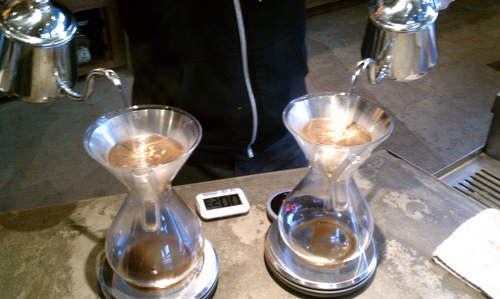In the coffee shops of Portland, one of the trendiest things you can get is a coffee brewed using the pour-over brewing method (this is not exclusive to Portland, as you can see by reading this CoffeeGeek.com discussion). Most, if not all, of the specialty cafés around town offer customers the pour-over option. The baristas at these shops may soon have some new competition—from a robot.
The pour-over is a very old brewing method, but it is being revived for several reasons, not least of which because it makes great coffee theater. Baristas delicately pour thin, even streams of water over freshly-ground coffee, concentrating hard to evenly wet the grounds. Some have a special pouring pattern that they believe improves the results. The single serving pour-over method guarantees that you get the freshest coffee possible. When coffee is made this way, much of the brightness and fruity notes really stand out. If the barista uses a Melitta or Chemex filter, as most do, the coffee is also very clean.
 The double pour-over. You can see how it might be difficult to pull this off effectively.
The double pour-over. You can see how it might be difficult to pull this off effectively.
The pour-over has its drawbacks though. First, it can be slow. If you are in a hurry when you buy coffee, you might not love the method, because it takes longer than picking up a cup of previously-brewed coffee. Second, pour-overs can be inconsistent because they rely on baristas to be focused on what they are doing. Distracted baristas who are in a hurry can make mistakes, and the results are not good. If the water is not poured correctly, the result is an uneven extraction that does not have the full flavor you expect and deserve.
To overcome this second problem, the inventors of the Clover have come up with a machine to make a more consistent pour-over. Roy Street Coffee in Seattle (an incognito Starbucks test café) has installed the Clover Precision Pourover, and if you didn’t see it on Friday, I encourage you to click here to watch the video at Gizmodo (they aren’t letting people embed the video on other sites). When you do, you will see how the machine pours a constant stream of water and the smooth rotation of the filter below ensures that all of the grounds are saturated evenly. The machine brews the coffee the same way every time.
Having this kind of pour-over machine is another example of how technological innovations perform jobs that were once done by humans. You might think of this as a good thing, depending on your beliefs about new technology. Generally, in the United States, we tend to subscribe to the idea that technological advance is naturally (and always) good. Anything that speeds up production, reduces variation and reduces costs is assumed by managers to be a positive thing. The counterpoint to this is that robots take jobs from people and this can inflict real pain on society (e.g., Detroit).
Thankfully, in the case of pour-over coffee, this new robot is unlikely to displace many workers. After all, someone has to run it, and the machine cannot replace the friendly banter with a barista that keeps bringing you back to your favorite café—at least not yet. The robot does take some of the charm out of the café experience, but the trade-off is a more consistent cup of coffee, which will convince many people that it is worth it. Personally, I’m willing to take a few inconsistent pour-overs in exchange for a barista with personality. Are you?